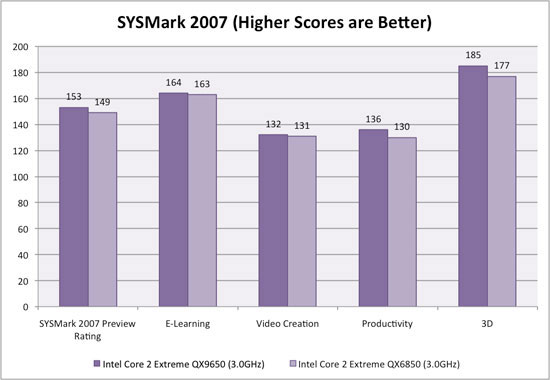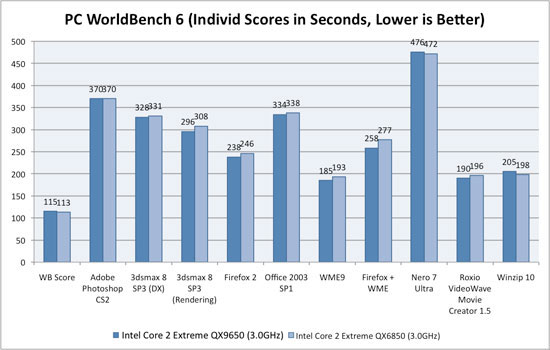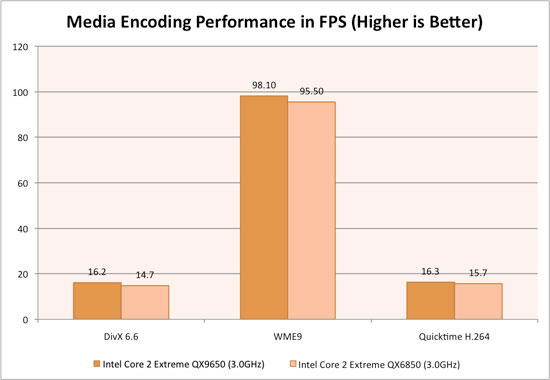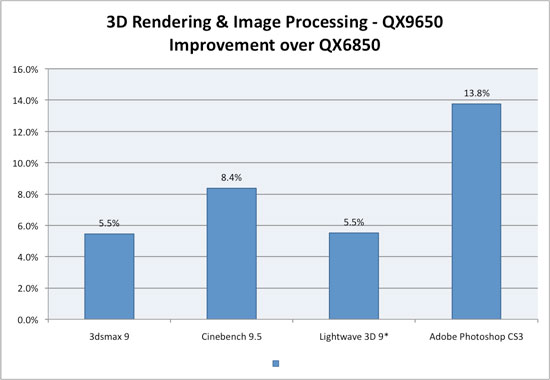Intel Core 2 Extreme QX9650 - Penryn Ticks Ahead
by Anand Lal Shimpi on October 29, 2007 12:13 AM EST- Posted in
- CPUs
Everything You Need to Know: Yorkfield vs. Kentsfield
The big question is: how does Yorkfield stack up to Kentsfield, the current 65nm quad-core part from Intel? Thankfully, the QX9650 runs at the same clock speed/FSB as the Kentsfield-based QX6850 making our job a little easier. We put these two bad boys up against one another and waited for the smoke to clear.

As we saw in our initial Penryn preview, the general application suite tests just don't show any real improvements of Penryn over Conroe. SYSMark 2007's overall performance went up by 2.6% but that's far from significant. If you look at the individual tests however, you'll see that the 3D benchmarks went up by 4.5% and the productivity suite went up by a similar 4.6% margin. The improvements in the 3D suite are expected, given the Radix-16 and Super Shuffle Engine enhancements to the Penryn core. The productivity suite most likely benefits from the Radix-16 divider as well as the larger cache. Overall the performance boost just isn't that significant, but given that Penryn is expected to arrive without a price premium, any performance improvement is better than nothing.

We see the same situation under PC WorldBench 6: the overall performance boost of Penryn over Conroe is basically nil. Digging deeper we see performance increases on the order of 4 - 7% if we look at the individual 3D rendering or media encoding tests.
Next up we've got our encoding tests, and given what we've already seen, we should expect some nice gains here:

And nice gains we do get. The clock-for-clock improvement under DivX 6.6 is a nice and round 10%, although curiously enough we get a meager 3% from our Windows Media Encoder test. Our QuickTime H.264 test shows a more average 4% performance increase, similar to our WME test.
Professional 3D rendering and image manipulation are also areas where we expect to see reasonably high gains from Penryn. Our 3dsmax, Cinebench and Lightwave tests remain unchanged from previous articles. The CS3 benchmark is the same Retouch Artists test we've used in previous CPU reviews. In order to avoid having a graph scale that ranged from zero to the thousands we simply included percentage improvements here rather than actual numbers (e.g. 3dsmax scores are single digits while Cinebench scores are 4 digits):

As expected, we're seeing reasonable gains here. 3dsmax shows a 5% increase, Cinebench 8%, Lightwave 6% and Photoshop CS3 has a healthy 10% performance boost in store for us. Without a doubt encoding and 3D/image manipulation are the real strengths of Intel's Penryn architecture.
The final Penryn test is all about 3D gaming and thankfully we have a number of new titles to play with. All of our benchmarks were run at 1024 x 768 to avoid being GPU bound and with high quality settings (the exceptions being Crysis and World in Conflict which both used Medium quality defaults).

* Denotes performance in minutes, lower is better
Penryn's gaming performance is really all over the place. Titles like Oblivion and Bioshock see absolutely no performance increase, while Crysis gives us a mild 3.7% performance boost. Half-Life 2: Episode Two and Unreal Tournament 3 enjoy a 5.1% and 6.4% increase respectively, while World in Conflict and Quake Wars are both at around 9%.
If anything the gamut of gaming benchmarks sums up Penryn's performance improvement over Conroe quite well: it really varies from nothing to something.










16 Comments
View All Comments
emenk - Sunday, January 20, 2008 - link
From first page (this article): "As we saw in our original Penryn preview, Penryn's cache performance remains unchanged; latencies in our final stepping are identical to Conroe."From the original Penryn preview (3rd page):
"Not only is Wolfdale's L2 cache larger, but it also happens to be slightly faster than its predecessor. Intel has shaved off a single clock cycle from Wolfdale's L2 access time; we're already off to a good start."
Isn't this a contradiction?
Ignore this (testing quote tags):
[quote]Quote goes here.[/quote]
IntelUser2000 - Tuesday, October 30, 2007 - link
You know that will not be true in the true Phenom comparison right Anand?? Take a look here: http://techreport.com/articles.x/8236/14">http://techreport.com/articles.x/8236/14Dual Opteron is slower than a Single Opteron, yet you still used Dual Opteron against a single Barcelona. Why?? No really, WHY?!?
"Because of these limitations we refrained from running any comparative benchmarks to desktop Athlon 64 X2s, instead we chose to run a single quad-core Opteron in our server platform against a pair of dual-core Opterons to simulate Phenom vs. K8 on the desktop."
You could have took games like Oblivion with Single socket Opteron to see the real advantages. This is the worst comparison, ever. And to make it worse, you put "simulated" benchmarks.
victory - Tuesday, October 30, 2007 - link
Wouldn't Intel be able to take immediate advantage of the new SSE4instructions in a new integrated graphics chipset perhaps then
competing with nVidia as well as beating AMD's integrated chipsets?
magreen - Monday, October 29, 2007 - link
It does 4GHz easily on the stock cooler? So why don't you strap a TR ultra 120 ex on there and tell us what it can really do? Cmon Anand, stop teasing us and tell us what we really want to know!AnnihilatorX - Monday, October 29, 2007 - link
It's a shame that they delay the release date of more affordable Yorkfields to January, just missed to Christmas sales.I am p0lanning to upgrade my computer and not sure whether to wait for Yorkfield or buy a Q6600.
idgaf13 - Monday, October 29, 2007 - link
Intel is trying to suppress Christmas sales and have a negative influence on "other companies" earnings while relieving themselves of Old Inventory.45nm process is going to produce so many CPUs per wafer that prices will fall fast or inventory will rise quickly.
With respect to the traditional cycle of product releases and price changes ,
A January launch date allows for the longest possible time before prices begin to tumble
typically after the trade shows in the first two quarters of the year.
It also more time to perfect the production process.
Question is do really need to be "the first on the block" to have this CPU ?
Or can you wait until the price falls by 50% or June/July for the best price?
Possibly even a faster CPU by then.
MGSsancho - Monday, October 29, 2007 - link
anand, could you be so kind as to point to where you got the info on the new sse4 instructions? the chart would be cool but some pdfs or something from into would be awsomejsaldate - Friday, November 9, 2007 - link
Penryn SDK: http://softwarecommunity.intel.com/articles/eng/11...">http://softwarecommunity.intel.com/articles/eng/11...http://softwarecommunity.intel.com/articles/eng/11...Ryan Smith - Monday, October 29, 2007 - link
http://www.intel.com/technology/architecture-silic...">From Intel's websiteMGSsancho - Monday, October 29, 2007 - link
thanks a lot =)